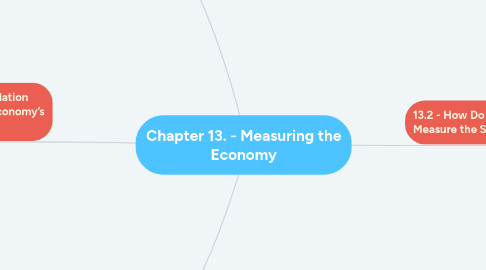
1. 13.3 - What Does the Unemployment Rate Tell Us About an Economy’s Health?
1.1. The unemployment rate is an indicator of the health of an economy. A high unemployment rate means the overall health of the economy is poor.
1.1.1. Unemployment Rate: the percentage of the labor force that is not employed but is actively seeking work
1.2. The BLS reports the total number of people who were unemployed for the previous month
1.3. Based on those data and further research, economists identify four types of unemployment: frictional, structural, seasonal, and cyclical.
1.4. When an economy reaches full employment, jobs exist for EVERYONE who wants to work.
1.4.1. Natural Rate of Unemployment: the percentage of the labor force without work when the economy is at full employment; a condition in which the economy is strong and there is no cyclical unemployment
2. 13.4--What Does the Inflation Rate Reveal About an Economy’s Health?
2.1. The inflation rate is the percentage increase in the average price level and it is tracked by the same government agency that tracks the unemployment rate.
2.2. The price a person pays for their good is its nominal cost, or its cost in current dollars.
2.2.1. Nominal Cost of Living: the cost in current dollars of all the basic goods and services needed by the average consumer
2.2.2. Real Cost of Living: the cost in constant dollars of all the basic goods and services needed by the average consumer; the nominal cost of living adjusted for inflation
2.3. Hyperinflation is like a runaway inflation created by extreme uncertainty in an economy.
2.3.1. Creeping Inflation: a gradual, steady rise in the price of goods and services over time
2.4. Deflation occurs when prices go down over time.
3. 13.5 - How Does the Business Cycle Relate to Economic Health?
3.1. The business cycle consists of four phases. Expansion, peak, contraction, & trough
3.2. Business cycles are irregular in both length and severity.
3.3. Business cycles are popularly known as periods of boom and bust. A boom is the expansion phase of the cycle.
3.3.1. Leading Economic Indicators: measures that consistently rise or fall several months before an expansion or a contraction begins
3.3.2. Lagging Economic Indicators: measures that consistently rise or fall several months after an expansion or contraction begins
3.4. On rare occasions, a recession will last a long time and cause serious damage to the economy. Economists refer to this kind of severe contraction as a depression
4. 13.2 - How Do Economists Measure the Size of an Economy?
4.1. Measuring of the size of a nation's economy is its gross domestic product (GDP).
4.1.1. Gross Domestic Product: the market value of all final goods and services produced within a country during a given period of time
4.2. GDP figures whether it is growing or shrinking and at what rate.
4.3. Effects of inflation a department calculates what is called real GDP.
4.3.1. Nominal GDP: a measure of a country’s economic output (GDP) valued in current dollars; nominal GDP does not reflect the effects of inflation
4.3.2. Real GDP: a measure of a country’s economic output (GDP) valued in constant dollars; real GDP reflects the effects of inflation
